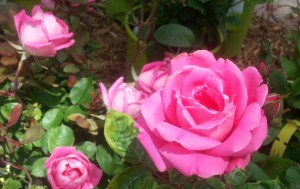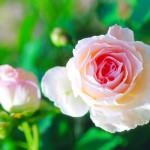How Hardy are Roses… Really.
How Hardy are Roses… Really.
Roses sometimes get a bum rap for being tender and high maintenance. And while that is partially true for the classic hybrid teas, which need to be mulched and protected in the winter (and prayed over), there are plenty of roses that are definitely not pansies. Which begs the question- Why do we use the word “pansy” to mean someone or something that is not very tough? Pansies are one of the hardier flowers out there… but I digress.
So, to answer the question I posed in the title, hybrid tea roses are generally listed as Zone 6, which means they are only hardy to about -10 degrees. But if we mulch them well in late fall those of us in zone 4 can usually bring them through most winters just fine. And if you are primarily looking for fragrance, or for long stems to be cut and placed in a vase inside, the hybrid teas just can’t be beat.
But If you are looking for a rose that is hardy and easy to care for, choose a variety from the list below. These roses have been selected for their hardiness, disease resistance, and ease of care. Most of them require minimal spraying, and pruning is generally limited to an annual pruning in the spring to remove any winter die-back. Some of them are so tough they will go through the most grueling of winters unscathed. Others will often die back to the snowline in winter and then re-flush and bloom on new growth the following year. Many of them, including the Parkland and Explorer series, were bred in Canada specifically for their ability to withstand harsh winters.
Most varieties are grown on their own rootstock so if they die back to the root they will still come back true to variety. Nearly all of them bloom in clusters and therefore are not the best choices for use as cut flowers.
Hardiness Zone: Zone 3 roses are hardy to about -40°F., Zone 4 to about -30° F., and Zone 5 to about -20° F.
Time of Bloom:
Everblooming plants will bloom more or less continually from mid June until hard frost.
Recurrent bloomers will blossom heavily, stop for a period, and then bloom once again, sometimes several times per season.
Non-recurrent bloomers bloom only once, usually for 2 to 3 weeks in mid to late June.
| Variety | Hardy Zone |
Type |
Height in feet | Bloom Size/Form | Color | Time of Bloom | Frag-rance | Remarks |
| Bonica | 4 | Shrub | 3-5 | 3” Double | Pink | Everbloom | No | Seed hips bright orange |
| Carefree Series | 4 | Shrub | 3-5 | 3” Semi/Double | Pinks, Yellow | Everbloom | Slight | Disease resistant series, attractive bright green foliage |
| Champlain | 3 | Hybrid kordesii | 3 | 2½-3 Double | Dark red | Everbloom | Slight | Floribunda flowers |
| Easy Elegance Series | 4 | Shrub | 3-5’ | Single, Semi, Double | Pink, Red, Yellow, Apricot, White | Everbloom | Varies with selection | More fragrant than most shrub roses |
| Knockout/ Pink Knockout | 4 | Shrub | 3’ | 3-3 ½ Single | Cherry Red/Pink | Everbloom | 2000 AARS winner | |
| Double Knock Out/ Pink Dbl. Knockout | 4 | Shrub | 3’ | 3” Double | Cherry Red/ Pink | Everbloom | Very double blossoms | |
| Morden Series | 3 | Shrub | 3-5’ | Semi, Double | Pinks, Yellow | Recurrent | Good Hardiness | |
| Scarlet Meidiland | 4 | Shrub | 3-4’ | 1-1 ½ Double | Medium Red | Everbloom | Spreading habit | |
| Therese Bugnet | 3 | Rugosa | 5-6 | 3-4 Double | Pink | Recurrent | Yes | Red buds, few thorns |
| Winnipeg Parks | 3 | Shrub | 2-3 | 2½-3 Semi Double | Deep Pink | Everbloom | ||
| CLIMBERS | ||||||||
| Henry Kelsey | 3 | Hybrid Kordesii | 6-7 | 3-4 Double | Medium Red | Recurrent | Yes | Flowers in large clusters |
| John Davis | 3 | Hybrid Kordesii | 6-8 | 3 Double | Medium Pink | Recurrent | Disease resistant | |
| William Baffin | 3 | Hybrid Kordesii | 8-10 | 2½-3 Semi Double | Deep Pink | Recurrent | No | Disease resistant |
By the way, the worlds hardiest rose is probably Rosa woodsii, or Wood’s Rose. It is native throughout much of North America including Idaho and most of Canada and Alaska. Though it is not often used in the landscape because the flowers tend to be small, sparse, and nothing to write home about, it is certainly hardy- at least Zone 2 (-50 degrees F.)




